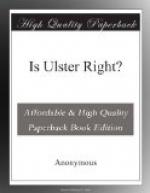This, however, is only one of many errors into which English writers have fallen. Mistakes of course will always be made; but unfortunately it is a charge from which Mr. Gladstone’s admirers cannot clear him that when he wished to bring the English people round to the idea of Home Rule he deliberately falsified Irish history in order to make it serve his ends; and his misrepresentations have gained credence amongst careless thinkers who are content to shelter themselves under a great name without looking at what has been written in answer. The general idea of an average Englishman about Irish history seems to be that Ireland in Celtic times was a peaceful, orderly, united kingdom, famous for its piety and learning, where land was held by “tribal tenure”—that is, owned by the whole tribe who were closely related in blood—rent being unknown, and the chief being elected by the whole tribe in solemn assembly. Into this happy country came the Norman invaders, who fought against and conquered the king; drove the native owners out of their possessions, and introduced a feudal system and an alien code of law unsuited to the people; and the modern landlords are the representatives of the conquering Normans and the tenants the descendants of the ancient tribesmen who naturally and rightfully resist paying rent for the lands which by ancestral right should be their own. There could not be a more complete travesty of history.
The Celtic Church no doubt had its golden age. It produced saints and men of learning. It sent out its missionaries to the heathen beyond the seas. So famous were its schools that students came to them from distant lands. But centuries before the Normans appeared in Ireland the salt had lost its savour. The Celtic Church had sunk into being a mere appendage of the wild tribes it had once tried to tame. The chiefs of one tribe would sack the colleges and shrines of another tribe as freely as they would sack any of their other possessions. For instance, the annals tell us that in the year 1100 the men of the south made a raid into Connaught and burned many churches; in 1113 Munster tribe burned many churches in Meath, one of them being full of people; in 1128 the septs of Leitrim and Cavan plundered and slew the retinue of the Bishop of Armagh; in the same year the men of Tyrone raided Down and a great number of people suffered martyrdom; four years later Kildare was invaded by raiders from Wexford, the church was burnt and many men slain; and so on with dreary monotony. Bishops and abbots fought in the incessant tribal wars as keenly as laymen. Worse still, it was not infrequent for one band of clergy to make war on another. In the ninth century, Phelim, who claimed to be both Bishop and King of Leinster, ravaged Ulster and murdered its monks and clergy. In the eleventh century the annals give an account of a fierce battle between the Bishop of Armagh and the Bishop of Clonard. Nor did time work any improvement; we read of bloody conflicts between abbots and bishops as late as the middle of the fifteenth century. What influence for good could such a church have had upon the mass of the people?




